Reconstruction of Heel Soft Tissue Defects Using Sensate Medial Plantar Flap
Highlights
- Reconstruction of calcaneal soft tissue defects implies a special technique, using a skin highly resistant to pressure and well-innervated.
- Sensate medial plantar fasciocutaneous flap can be a good solution for reconstruction of such calcaneal soft parts defects.
Highlights
- Reconstruction of calcaneal soft tissue defects implies a special technique, using a skin highly resistant to pressure and well-innervated.
- Sensate medial plantar fasciocutaneous flap can be a good solution for reconstruction of such calcaneal soft parts defects.
Abstract
Introduction
Materials and Methods
Results
Discussions
Conclusions
Conflicts of Interest
Compliance with ethical standards
References
- Benito-Ruiz, J.; Yoon, T.; Guisantes-Pintos, E.; Monner, J.; Serra-Renom, J.M. Reconstruction of soft- tissue defects of the heel with local fasciocutaneous flaps. Ann Plast Surg. 2004, 52, 380–384. [Google Scholar] [CrossRef] [PubMed]
- Harrison, D.H.; Morgan, B.D. The instep island flap to resurface plantar defects. Br J Plast Surg. 1981, 34, 315–318. [Google Scholar] [CrossRef] [PubMed]
- Macedo, J.L.S.; Rosa, S.C.; Neto, A.V.R.F.; Silva, A.A.D.; Amorim, A.C.S. Reconstruction of soft-tissue lesions of the foot with the use of the medial plantar flap. Rev Bras Ortop. 2017, 52, 699–704. [Google Scholar] [CrossRef] [PubMed]
- Paget, J.T.; Izadi, D.; Haj-Basheer, M.; Barnett, S.; Winson, I.; Khan, U. Donor site morbidity of the medial plantar artery flap studied with gait and pressure analysis. Foot Ankle Surg. 2015, 21, 60–66. [Google Scholar] [CrossRef] [PubMed]
- Ishikawa, K.; Isshiki, N.; Suzuki, S.; Shimamura, S. Distally based dorsalis pedis island flap for coverage of the distal portion of the foot. Br J Plast Surg. 1987, 40, 521–525. [Google Scholar] [CrossRef] [PubMed]
- Baker, G.L.; Newton, E.D.; Franklin, J.D. Fasciocutaneous island flap based on the medial plantar artery: Clinical applications for leg, ankle, and forefoot. Plast Reconstr Surg 1990, 85, 47–58. [Google Scholar] [PubMed]
- Gillies, H.; Millard, D. The principles and art of plastic surgery; Butterworth: London, UK, 1957; Volume 2, pp. 368–384. [Google Scholar]
- Shanahan, R.E.; Gingrass, R.P. Medial plantar sensory flap for coverage of heel defects. Plast Reconstr Surg. 1979, 64, 295–298. [Google Scholar] [PubMed]
- Wan, D.C.; Gabbay, J.; Levi, B.; Boyd, J.B.; Granzow, J.W. Quality of innervation in sensate medial plantar flaps for heel reconstruction. Plast Reconstr Surg. 2011, 127, 723–730. [Google Scholar] [CrossRef] [PubMed]
- Weinzweig, N.; Davies, B.W. Foot and ankle reconstruction using the radial forearm flap: A review of 25 cases. Plast Reconstr Surg. 1998, 102, 1999–2005. [Google Scholar] [CrossRef] [PubMed]
- Rashid, M.; Hussain, S.S.; Aslam, R.; Illahi, I. A comparison of two fasciocutaneous flaps in the reconstruction of defects of the weight-bearing. J Coll Physicians Surg Pak. 2003, 13, 216–218. [Google Scholar] [PubMed]
- Schwarz, R.J.; Negrini, J.F. Medial plantar artery island flap for heel reconstruction. Ann Plast Surg. 2006, 57, 658–661. [Google Scholar] [CrossRef] [PubMed]
- Mourougayan, V. Medial plantar artery (instep flap) flap. Ann Plast Surg. 2006, 56, 160–163. [Google Scholar] [CrossRef] [PubMed]
- Alius, C.; Oprescu, S.; Balalau, C.; Nica, A.E. Indocyanine green enhanced surgery; principle, clinical applications and future research directions. J Clin Invest Surg. 2018, 3, 1–8. [Google Scholar] [CrossRef]
- Trevatt, A.E.; Filobbos, G.; UIHaq, A.; Khan, U. Long- term sensation in the medial plantar flap: A two- centre study. Foot Ankle Surg. 2014, 20, 166–169. [Google Scholar] [CrossRef] [PubMed]
- Gu, J.X.; Huan, A.S.; Zhang, N.C.; Liu, H.J.; Xia, S.C.; Regmi, S.; Yang, L. Reconstruction of Heel Soft Tissue Defects Using Medial Plantar Artery Island Pedicle Flap: Clinical Experience and Outcomes Analysis. J Foot Ankle Surg. 2017, 56, 226–229. [Google Scholar] [CrossRef] [PubMed]
- Oh, S.J.; Moon, M.; Cha, J.; Koh, S.H.; Chung, C.H. Weight-bearing plantar reconstruction using versatile medial plantar sensate flap. J Plast Reconstr Aesthet Surg. 2011, 64, 248–254. [Google Scholar] [CrossRef] [PubMed]
- Yang, D.; Yang, J.F.; Morris, S.F.; Tang, M.; Nie, C. Medial plantar artery perforator flap for soft-tissue reconstruction of the heel. Ann Plast Surg. 2011, 67, 294–298. [Google Scholar] [CrossRef] [PubMed]
- Budiman-Mak, E.; Conrad, K.J.; Roach, K.E. The Foot Function Index: A measure of foot pain and disability. J Clin Epidemiol. 1991, 44, 561–570. [Google Scholar] [CrossRef] [PubMed]
- Enneking, W.F.; Dunham, W.; Gebhardt, M.C.; Malawar, M.; Pritchard, D.J. A system for the functional evaluation of reconstructive procedures after surgical treatment of tumors of the musculoskeletal system. Clin Orthop Relat Res. 1993, 286, 241–246. [Google Scholar] [CrossRef] [PubMed]
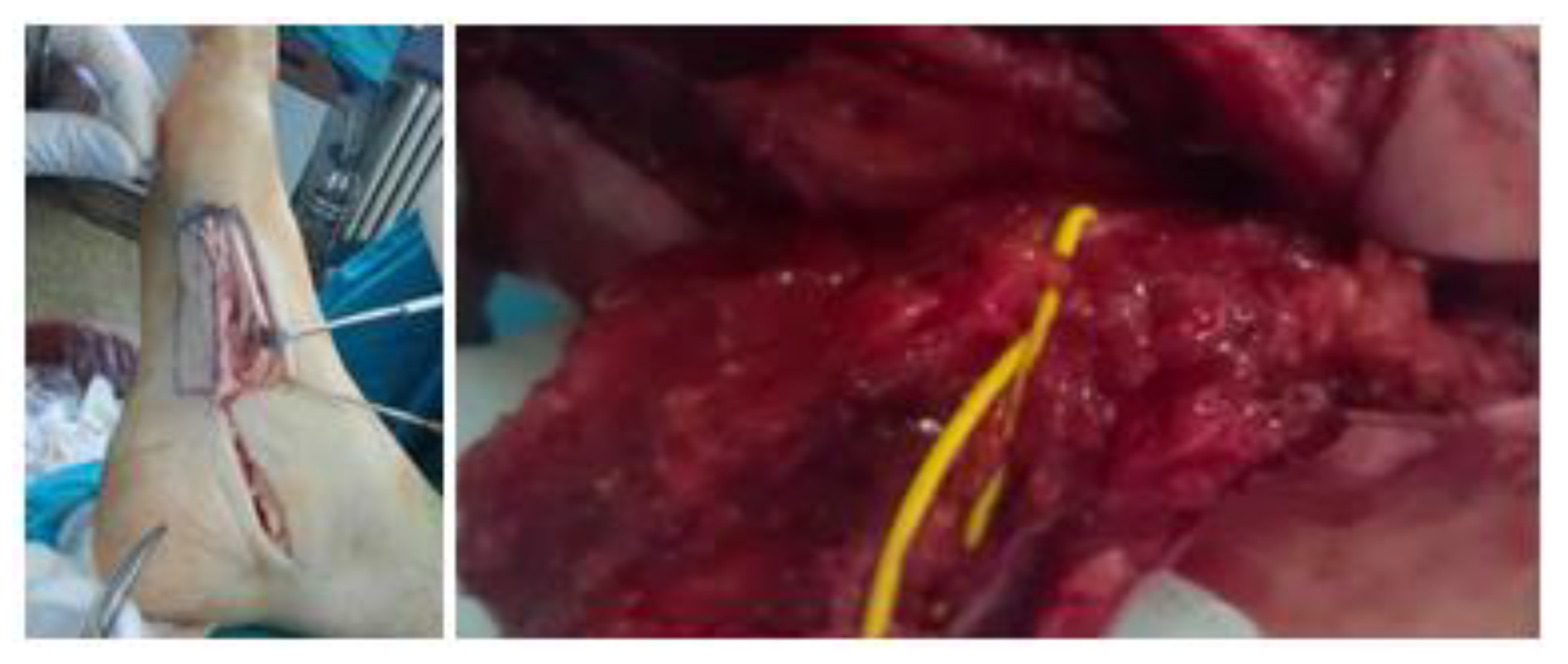
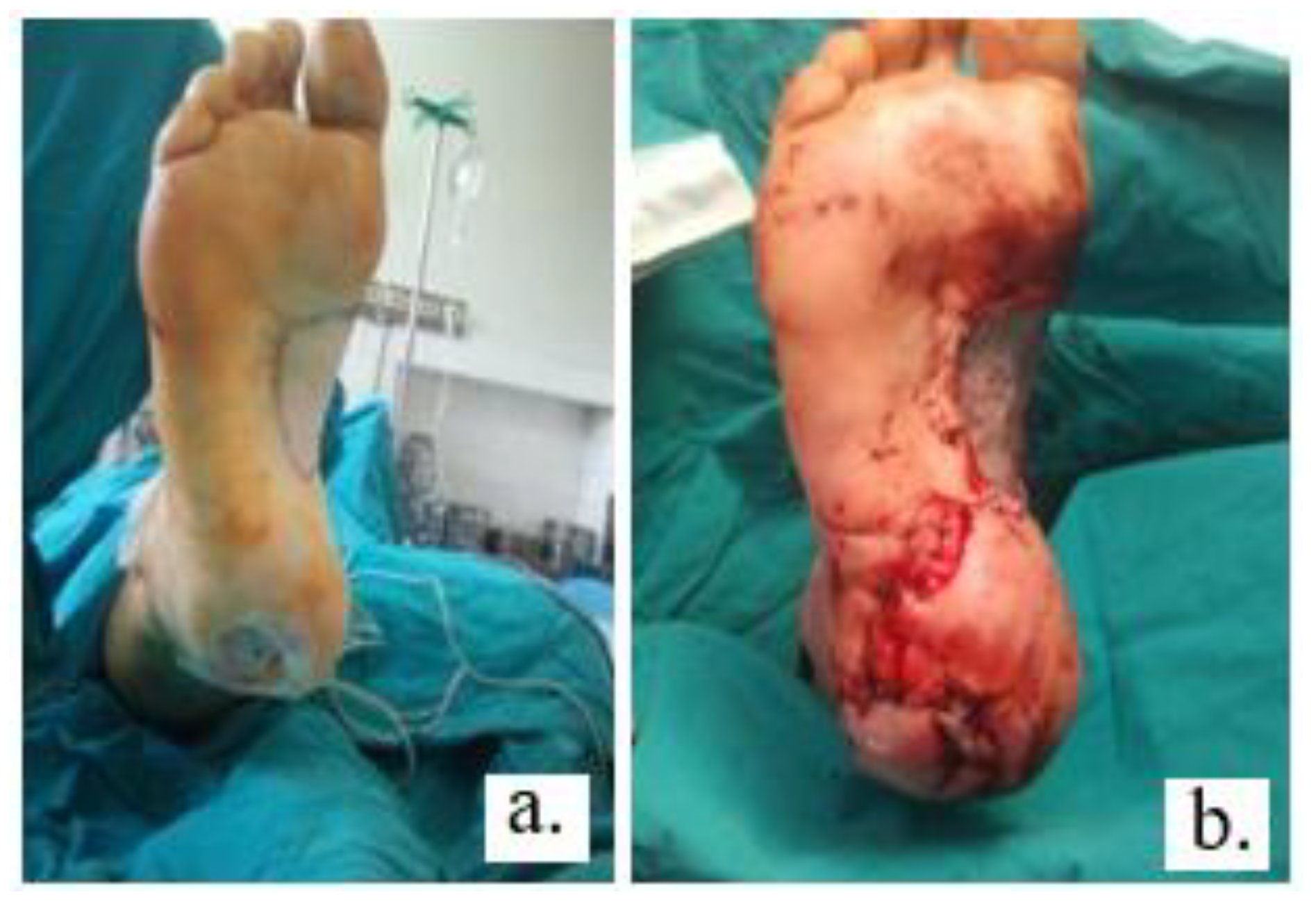
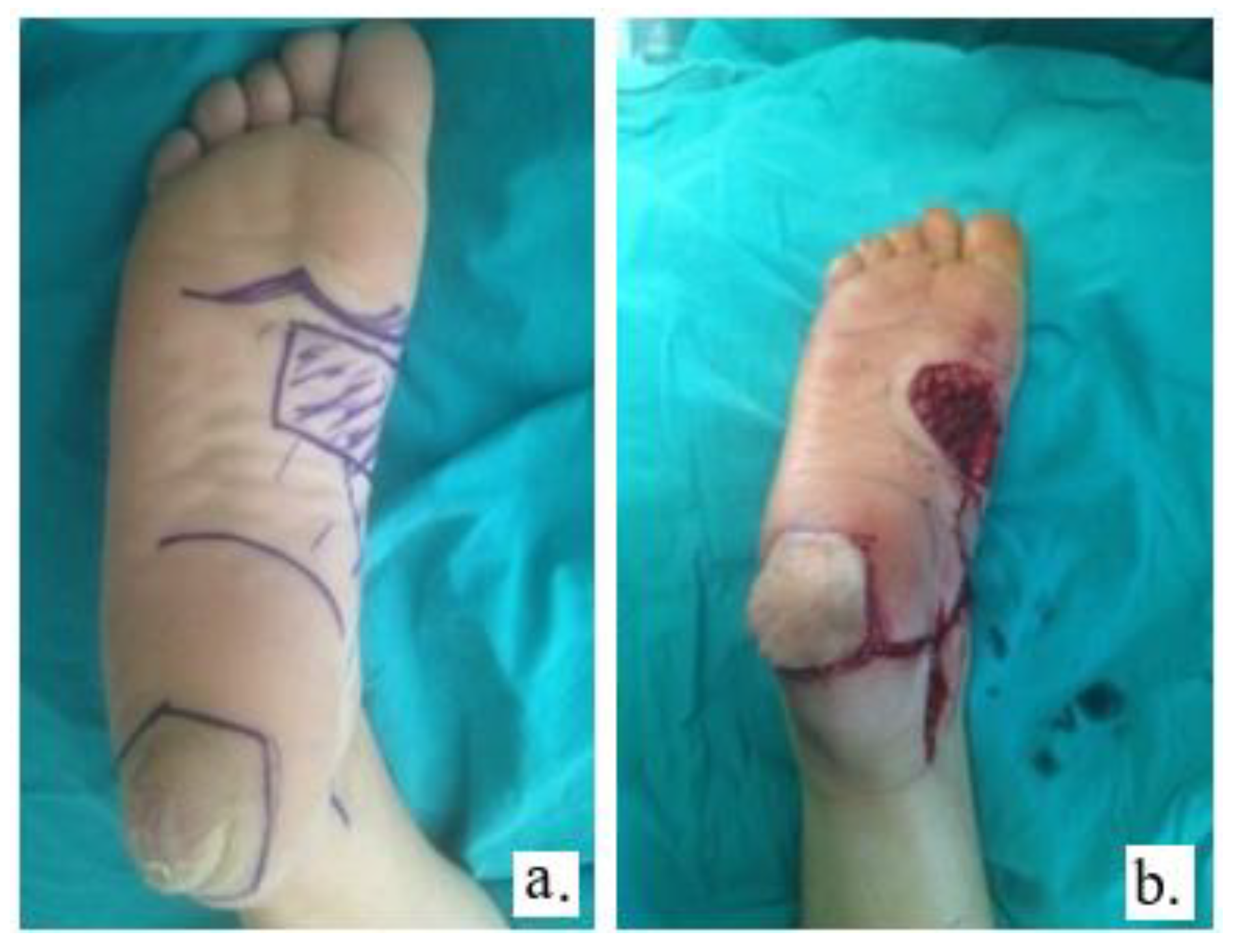
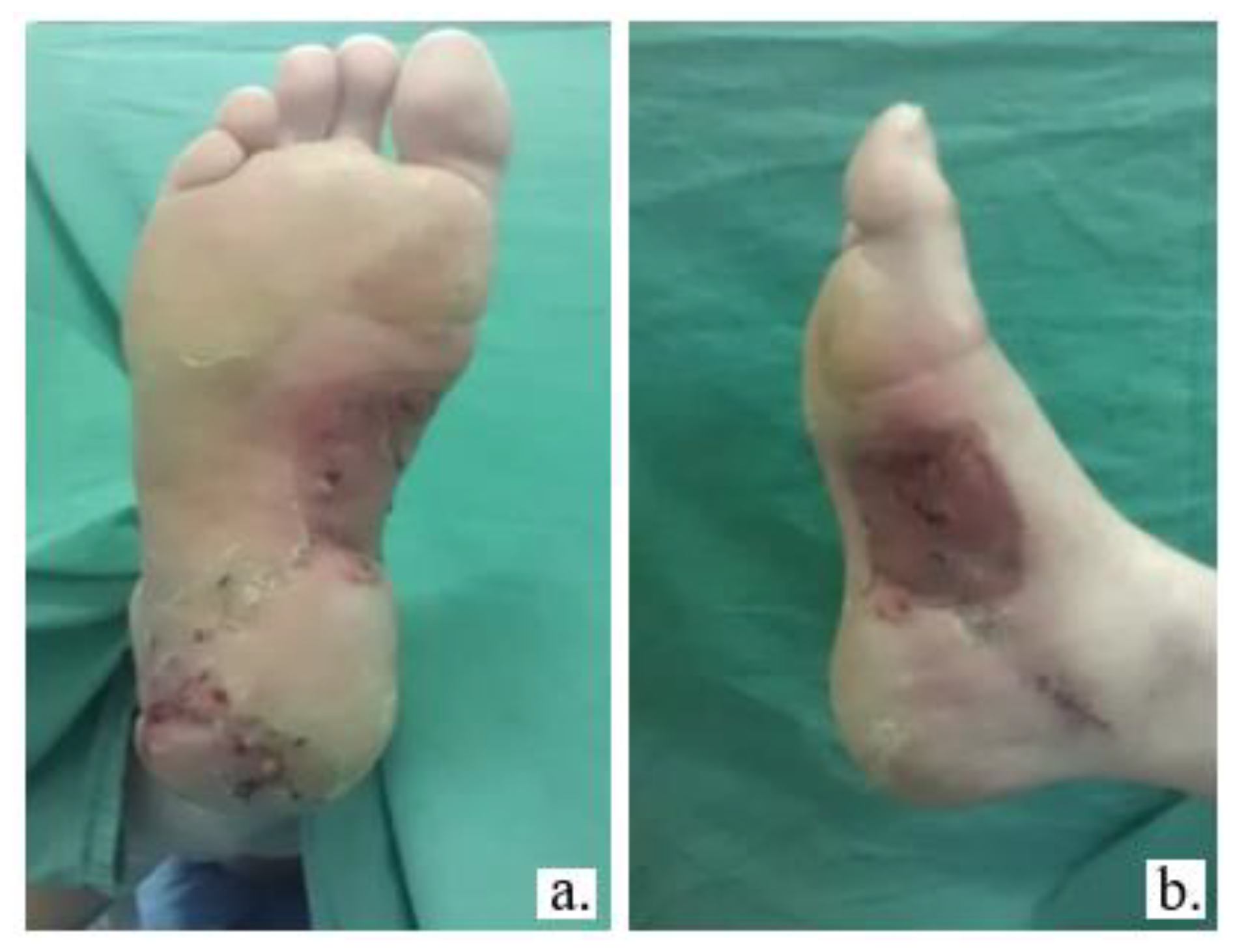
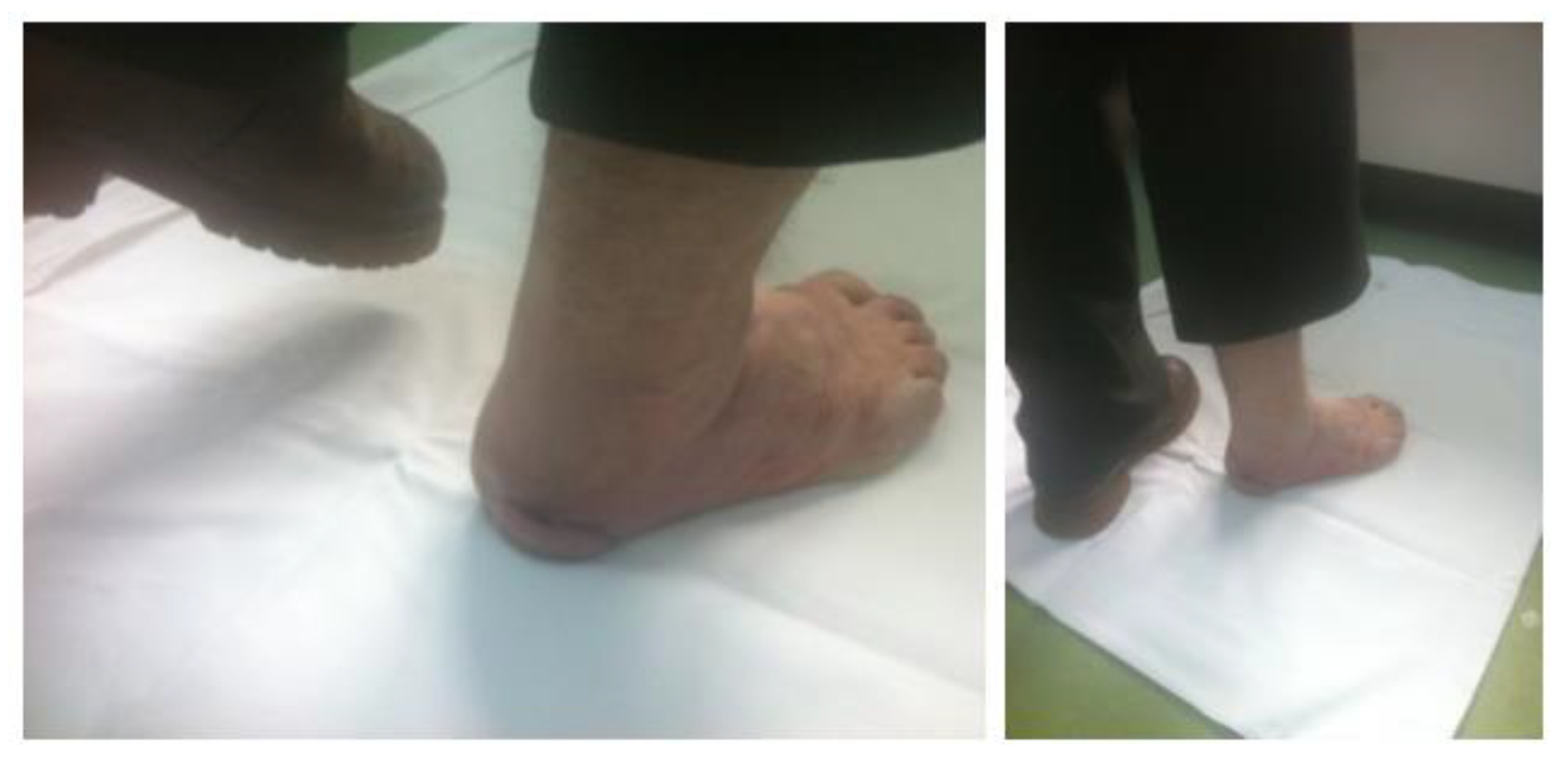
© 2018 by the author. 2018 Mihaela Pertea, Natalia Velenciuc, Oxana Grosu, Bogdan Veliceasa, Vladimir Poroch and Sorinel Lunca
Share and Cite
Pertea, M.; Velenciuc, N.; Grosu, O.; Veliceasa, B.; Poroch, V.; Lunca, S. Reconstruction of Heel Soft Tissue Defects Using Sensate Medial Plantar Flap. J. Mind Med. Sci. 2018, 5, 250-254. https://doi.org/10.22543/7674.52.P250254
Pertea M, Velenciuc N, Grosu O, Veliceasa B, Poroch V, Lunca S. Reconstruction of Heel Soft Tissue Defects Using Sensate Medial Plantar Flap. Journal of Mind and Medical Sciences. 2018; 5(2):250-254. https://doi.org/10.22543/7674.52.P250254
Chicago/Turabian StylePertea, Mihaela, Natalia Velenciuc, Oxana Grosu, Bogdan Veliceasa, Vladimir Poroch, and Sorinel Lunca. 2018. "Reconstruction of Heel Soft Tissue Defects Using Sensate Medial Plantar Flap" Journal of Mind and Medical Sciences 5, no. 2: 250-254. https://doi.org/10.22543/7674.52.P250254
APA StylePertea, M., Velenciuc, N., Grosu, O., Veliceasa, B., Poroch, V., & Lunca, S. (2018). Reconstruction of Heel Soft Tissue Defects Using Sensate Medial Plantar Flap. Journal of Mind and Medical Sciences, 5(2), 250-254. https://doi.org/10.22543/7674.52.P250254


